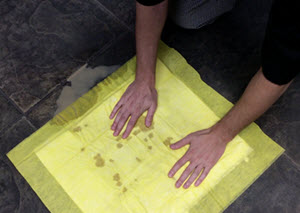Preventing Slip and Fall Accidents in Restaurant Kitchens
Posted on 14th Jul 2017

According to the National Floor Safety Institute (NFSI) and as reported by EHS Today , slip and fall accidents are the number one cause of injuries in the hospitality industry.
Looking at this statistic a bit closer, we find that most of these slip and fall accidents in restaurants do not occur in the dining room, but in the back-of-house, or the kitchen area.
This is where the estimated 135,000 chefs and cooks in the U.S. , along with kitchen staff, waiters, and other staff are working. And drilling even further into these numbers, we find that more than 70 percent of these slip and fall accidents occur on flat surfaces.
According to studies by Liberty Mutual Workplace Safetyand the National Safety Council, in most types of facilities, slips and falls are usually the result of physical obstructions on the floor—a folded mat, a loose floor drain cover, clutter, someone tripping over an extended power cord, or poor lighting.
Sometimes there are imperfections on the floor surface, where it rises or lowers slightly and unexpectedly, or there is an unexpected step up or step down, etc.
We can call these “dry” slip, trip, and fall accidents because the bulk of falls occur on a dry surface.
But in a restaurant, especially in the kitchen, the NFSI reports that many, if not the majority, of these slip and fall accidents are either the result of dangerous conditions or are considered “wet” slip and fall accidents. This is where a liquid, food item, oil, or grease has likely spilled on the floor.
The DayMark SafetyApplied™ Absorbent Spill Pad
We suggest that the less time the spill spends on the floor, the safer it will be for everyone in the restaurant—and in that spirit, we have introduced the SafetyApplied Absorbent Spill Pad.Knowing that the bulk of the slip and fall accidents in restaurants occur in the back-of-house and are most likely the result of some wet spill, what can we do to prevent these accidents?
Here are a few tips on how the pads work:
- Place a wet floor sign right next to the spill; because commercial kitchens tend to be small, very busy places, we can only block off the immediate area.
- Do not mop the problem area; if the mop is soiled, it can spread the spill and make the floor even more slippery.
- Cover the area with an absorbent spill pad.
- Use the absorbent spill pad as a large wipe or cleaning cloth, moving it over the spill. DayMark pads are as much as 8.5 times more absorbent than other pads—as a result, this will likely collect the entire spill.
To see the pads in action, check out this video .
It should be noted that these tips apply as long as it is known what the spill is. If there is concern that the spill is hazardous or the result of someone getting sick, then additional safety precautions should be taken, including using a disinfectant instead of an all-purpose cleaner.
For more information on slip and fall prevention in restaurants as well as other types of facilities, floor safety, DayMark’s spill absorption pads, contact a DayMark Representative .


